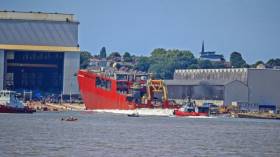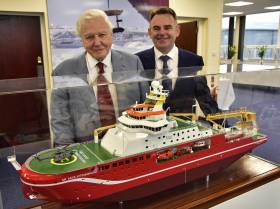Displaying items by tag: Sir David Attenborough
Belfast Welcomes Polar Research Vessel Sir David Attenborough
Belfast Lough welcomed the RRS Sir David Attenborough for the first time this past weekend for a crew change.
And its Captain Matt Neill, from Magilligan near Coleraine, told the Belfast Telegraph was “made up” to bring the ship to Northern Ireland.
The £200 million vessel has been conducting scientific trials en route to Belfast from Macduff in eastern Scotland, ahead of a planned Antarctic mission later this year.
While a public poll to name the research ship resulted in a top vote for ‘Boaty McBoatface’, that irreverent moniker was instead given to one of its robotic submersibles.
The Belfast Telegraph has more on the story HERE.
UK Polar Ship RRS Sir David Attenborough Handed Over to Research Council
Cammell Laird a UK shipbuilder on Merseyside, has achieved its final milestone for the RRS Sir David Attenborough by formally handing over the new polar ship to Britain's Natural Environment Research Council (NERC).
The royal research ship (RRS) to be operated by British Antarctic Survey (BAS) will transform UK research in the polar regions. Its missions will be critical for understanding and making sense of our changing climate.
Crews from BAS will spend the next 50 days undergoing intensive training at Holyhead Port, familiarising themselves with the ship and its equipment.
The 15,000 tonne ship will then embark on further operational and scientific trials where the team will test anchoring, manoeuvring, dynamic positioning and helideck landing. Early next year the ship will undertake ice trials in the Arctic, and in November 2021 make its maiden voyage to Antarctica.
As Afloat reported in October RRS Sir David Attenborough began sea trials having departed Cammell Laird’s Birkenhead facility. This stage had marked the culmination of a complex four year build programme that involved more than 1300 local personnel, 70 apprentices and many hundreds of specialist subcontractors and suppliers.
David McGinley, CEO of Cammell Laird Shiprepairers, Shipbuilders, Atlantic & Peninsula Services said: “This handover is the final milestone in what has been the most ambitious project in Cammell Laird’s recent history and we are proud that a vessel built here in the UK will contribute so much to our understanding of climate change.
“It’s also an important opportunity to reflect on the amount of collective expertise, commitment and sheer tenacity that has gone into this build. We’ve worked closely with NERC and BAS throughout and have shown that Cammell Laird is at the forefront of the global shipbuilding industry and ready to deliver future shipbuilding projects here on the River Mersey. We wish RRS Sir David Attenborough good luck and bid her a very, very fond farewell.”
Nigel Bird, Director of Major Programmes at NERC said: “The handover of the RRS Sir David Attenborough marks the end of the beginning. Seven years on from when the design process began, we have the keys to one of the most advanced polar research vessels in the world, and I want every person who has contributed to this extraordinary ship to know how proud UKRI-NERC are.”
Professor Dame Jane Francis, Director of BAS, said: “This exciting moment is a major milestone for us, and a big moment for all those who have spent the past four years working tirelessly to build this incredible vessel. We’ve seen it evolve from a pile of steel into this amazing state-of-the-art ship that’s going to allow us to do science that we’ve never done before.”
Research newbuild RRS Sir David Attenborough is set to undergo two weeks of technical trials off the coast of north Wales
The UK's most advanced polar research vessel set sail from Cammell Laird shipyard in Birkenhead on Wednesday morning (Afloat adds the newbuild this afternoon remains on Merseyside along the fasmous Liverpool waterfront).
It is operated by the British Antarctic Survey (BAS) and the crew on board the vessel will also undertake 50 days of intensive training at Holyhead Port, Anglesey once the technical trials have been completed.
The new vessel (launched in 2018) is expected to transform UK research in the polar regions, including extensive work designed to boost understanding of climate change.
It first came to public attention in March 2016, when a poll conducted to come up with a name for the vessel was topped with the suggestion 'Boaty McBoatface'.
NorthWalesLive has more here.
Newbuild: Sir David Attenborough Launches 'Boaty' Polar Ship
#MarineScience - This afternoon Sir David Attenborough launched the 10,000-tonne hull of the UK's newest polar ship - named after him - into the River Mersey.
The BBC reports the broadcaster pushed the button, sending the hull sliding out from the Cammell Laird yard in Birkenhead, into the water where building will continue.
"Our future will be effected by what people working on this ship will be discovering in years to come," he said.
It is "the greatest possible honour" to be its namesake, Sir David added.
The hull of the £200m research vessel entered the river stern-first, creating a big wave as it hit the water.
Ahead of the launch, the riverbed was dredged in front of the slipway to make sure the steel mass did not bottom out.
To read more on the launch of the newbuild, click here.
#ExportDrive -UK shipbuilder Cammell Laird that is building polar research vessel Sir David Attenborough, says it plans to unleash an ‘aggressive exports drive’ in 2017 after one of its busiest years for commercial marine work, which saw it land the biggest shipbuilding project in the UK for a generation.
“Winning the Sir David has thrust the Cammell Laird brand back to where it belongs in the global super league of shipbuilding,” he said. “We won it against fierce international competition and it sends a massive message to industry about the world class skills, facilities and workforce we have here. The complex nature of the build and the polar specifications required means very few shipyards now have our experience. We fully intend to market this polar capability hard in 2017 together with our wider expertise in the ship building, conversion and repair markets. Cammell Laird is fully behind the UK Government’s desire to see British shipbuilding aggressively pursue the exports market and promote Britain as an easy place to do business post Brexit. Cammell Laird is perfectly placed to become a giant engine creating wealth and skilled jobs across academic abilities for our community and the UK economy.
"Moreover, the recommendations made by Sir John Parker in his National Shipbuilding Strategy are very astute and stand to create more opportunity for shipyards like Cammell Laird to win work particularly in the naval new build sector, where again we have considerable experience with the recent aircraft carrier programme. Success within our maritime division will in turn enable us to diversify further into multi-billion pound energy markets like nuclear, oil and gas and renewables.”
Cammell Laird managing director Linton Roberts said the total number of drydockings and repairs in 2016 was more than 150 while workforce numbers peaked at 1050 in full time and contractor positions while apprentice numbers had grown by 21 to 79. In terms of other new build work he said the Birkenhead based yard had sent the Strangford Lough ferry ‘Strangford II’ for commissioning and sea trials before being delivered to her owners the Northern Ireland Executive at the beginning of October.
Mr Roberts said the range of the ships and breadth of work undertaken reinforced the capabilities within the company. He said Cammell Laird has undertaken repair and routine drydockings for a number of RoRo and RoPax customers including P&O Ferries, Stena Line, Seatruck Ferries, Irish Ferries, the Isle of Man Steam Packet Company and Caledonian McBrayne. Ships worked on include: Clipper Ranger, Ben-My-Chree, Clansman, Finlaggen, Isle of Arran, Isle of Lewis, Loch Portain, Lochinvar, Lord of the Isles, Isle of Inishmore, Jonathan Swift, Manannan, Norbank, Norbay, European Endeavour, Stena Performer, Seatruck Progress and Seatruck Pace.
Mr Roberts said the Caledonian MacBrayne’s flagship, the 2014-built ‘Loch Seaforth’, travelled from Ullapool for an 11 day dry dock in October, followed by the ‘Lord of the Isles’ and ‘Hebridean Isles’ in November. The ‘Isle of Mull’ is scheduled for the end of November. A variety of other types of vessels have also been accommodated. The Afon Dyfrdwy Airbus wing carrier was in drydock in July, and the Amazone paid a visit for hopper door repairs in the same month. Meanwhile The ‘Galileo G’ Expedition Superyacht was an exotic visitor in May.
Mr Roberts said Cammell Laird had seen a quieter year in RFA work ahead of an expected upturn in 2017. Cammell Laird has a through-life support cluster contract to maintain nine of the 13 ships in the RFA flotilla. However, the yard did undertake a dry docking and maintenance period for the RFA Fort Rosalie between October and November.
Elsewhere Cammell Laird repaired Mersey Ferries’ Royal Iris following a grounding at the entrance to the Manchester Ship Canal, and fellow Mersey Ferries Royal Daffodil and the dazzle-painted Snowdrop were also drydocked during the year. Meanwhile, bunker tanker Mersey Spirit, hopper barge HAM 602, jack-up Irish Sea Pioneer and tug Switzer Asgarth all visited the shipyard during 2016. The historic steam tugs Daniel Adamson and Kerne departed the shipyard in the middle of the year, both centenarians having completed comprehensive rebuilds. A new visitor to Birkenhead in November was the container vessel Rachel Borchard, docking for repairs.
Mr Roberts said work outside standard drydockings and repairs included a contract for the manufacture and installation of 400t of steelwork to be fitted on board the A2SEA Sea Installer for its upcoming deployment works on the Burbo 2 wind farm extension.
“The contract represented a significant win for the company,” he said. “The project has seen the manufacture of three main structures, two of which support 12 giant wind turbine blades with the remaining structure supporting four turbine towers. A range of deck fittings have also been manufactured to enable four nacelle hubs to be transported and installed offshore. The structures were delivered in 71 days, and were fitted in a 30 day installation period, showcasing our ability to react to challenges with short lead times. It is important to emphasize our multiple manufacturing locations, which position us ideally to continue to serve the offshore wind and renewables sector.”
































































